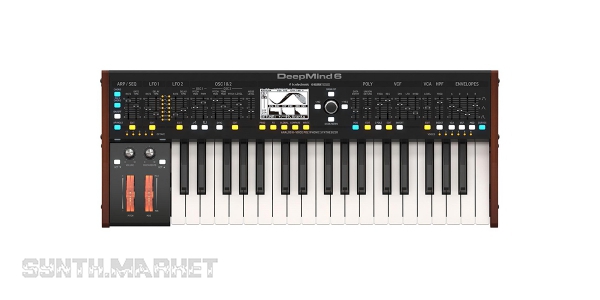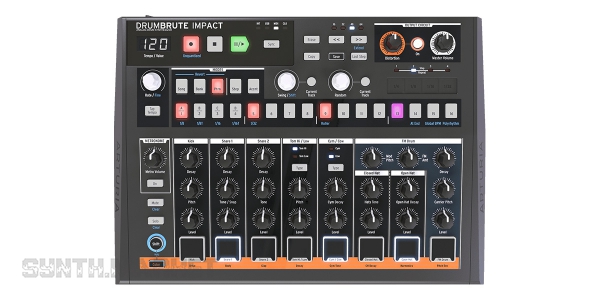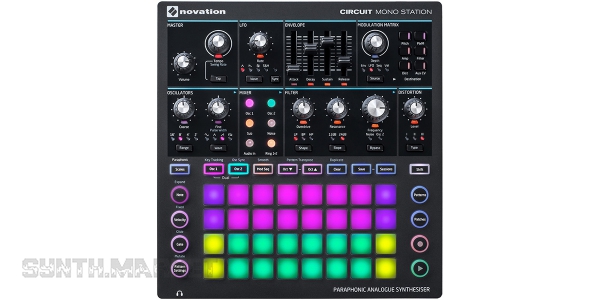Arturia DrumBrute Impact: $299
Circuit Mono Station: $499
Total setup cost: $1299
As the main synthesizer for generating pads, leads and bass, we offer an instrument from a well-known company Behringer - Deepmind 6. This is a polyphonic analog synthesizer with a 37-key semi-weighted pressure sensitive keyboard with monophonic aftertouch. Generally, it is a shortened version of Deepmind 12 tagged only $499 which is absolutely unbeatable price in its segment. It has digital control and its memory allows you to save up to 1024 presets. You can expand the options of managing the parameters by connecting the iPad/ PC/ Mac device via USB/ MIDI or MIDI protocols.
 The Deepmind 6 sound engine has a six-voice polyphony with two oscillators per voice. The oscillators are synchronized, and the first one generates waves of two forms (sawtooth, square) with the pulse width modulation control, the second one, providing only square waveform, modulates the pitch. The synthesizer has two modes: unison and polyphonic, both have features of voice detuning and voice panning. Each voice, in addition to the oscillators, can be shaped by 3 ADSR envelopes (amplifier, filter, modulation) and two LFOs with 7 waveforms and the ability to synchronize via MIDI. There is, of course, also an analog filter with resonance and two cutoff depth options (12 and 24 dB / oct) to choose from. All this already sounds quite powerful, taking into account the cost of the device, but it also has an 8-channel modulation matrix that significantly extends the modulation capabilities of almost all parameters of the synthesizer, including even effect parameters. The effects are worth mentioning separately: the instrument contains 4 effect processors from TC Electronic and Klark Teknik, which include more than 30 processing algorithms, including reverbs, chorus, flanger, phaser, delay and multi-band distortion. There are also, among other things, a noise generator, a 32-step sequencer and an arpeggiator on board of the synth. The latter have the ability to synchronize to MIDI, and the arpeggiator allows you to save and edit your patterns.
The Deepmind 6 sound engine has a six-voice polyphony with two oscillators per voice. The oscillators are synchronized, and the first one generates waves of two forms (sawtooth, square) with the pulse width modulation control, the second one, providing only square waveform, modulates the pitch. The synthesizer has two modes: unison and polyphonic, both have features of voice detuning and voice panning. Each voice, in addition to the oscillators, can be shaped by 3 ADSR envelopes (amplifier, filter, modulation) and two LFOs with 7 waveforms and the ability to synchronize via MIDI. There is, of course, also an analog filter with resonance and two cutoff depth options (12 and 24 dB / oct) to choose from. All this already sounds quite powerful, taking into account the cost of the device, but it also has an 8-channel modulation matrix that significantly extends the modulation capabilities of almost all parameters of the synthesizer, including even effect parameters. The effects are worth mentioning separately: the instrument contains 4 effect processors from TC Electronic and Klark Teknik, which include more than 30 processing algorithms, including reverbs, chorus, flanger, phaser, delay and multi-band distortion. There are also, among other things, a noise generator, a 32-step sequencer and an arpeggiator on board of the synth. The latter have the ability to synchronize to MIDI, and the arpeggiator allows you to save and edit your patterns.
 An analog Drumbrute Impact drum machine from the beloved French company Arturia is a great instrument for creating percussion sounds. A new one will cost you about $299 and some say Impact is better than its progenitor, the initial big Drumbrute. Drumbrute Impact is equipped with ten pure analog sounds, including Kick, Snare 1, Snare 2, Tom Hi, Tom Low, Cowbell, Cymbal, Closed Hat, Open Hat and FM Sound. The device also has a rather powerful 64-step sequencer with the ability to record up to 64 patterns. This drum machine has both classic and unique features:
An analog Drumbrute Impact drum machine from the beloved French company Arturia is a great instrument for creating percussion sounds. A new one will cost you about $299 and some say Impact is better than its progenitor, the initial big Drumbrute. Drumbrute Impact is equipped with ten pure analog sounds, including Kick, Snare 1, Snare 2, Tom Hi, Tom Low, Cowbell, Cymbal, Closed Hat, Open Hat and FM Sound. The device also has a rather powerful 64-step sequencer with the ability to record up to 64 patterns. This drum machine has both classic and unique features:
- Polyrhythm: allows you to set different lengths of patterns for different instruments;
- Looper: allows you to create beat offsets and glitches;
- Roller: designed for creating drum rolls;
- Songs: a function for combining several patterns into songs;
- Swing: adds groove to the song and can be applied to a whole song as well as to individual instruments;
- Randomness: adds randomness to patterns;
- Output distortion: overdrive effect for a dirtier sound;
- Color: adds harmonics to the sound of different drums, can be applied to a separate step as well as to the whole track. Its pure overdrive for kick and snare, and some kind of an exciter for hats and cymbals.
Drumbrute Impact has a standard I/O set that includes the main output and headphone output, MIDI input and output, input and output for the synchronization signal, 4 individual outputs for the kick, snare, hi-hat and FM sounds, and an USB bus (with MIDI over USB).
 Novation Circuit Mono Station, which in our opinion is the ideal third instrument in the analog setup, costs only $499. It may appear a very good deal if we think about its capabilities of paraphonic analog synthesizer and powerful step and pattern sequencer. Circuit Mono Station can be both a source of sound and a center for processing output signals from other devices and their sequencing. The machine has quite a few different inputs and outputs for this. Among them are MIDI, CV, USB, linear inputs outputs and one I/O for the synchronization signal. The main feature and convenience of the device is a thoughtful and convenient interface, which is really nice to communicate with and which makes the process of creating music on Circuit Mono Station an exciting activity. As for the synthesizer part of the device, it is a monophonic (paraphonic) analog synthesizer with digital control, perfectly suitable for creating interesting, albeit not too complex sounds. It is a tool with digital control and the ability to store up to 64 user presets. It has:
Novation Circuit Mono Station, which in our opinion is the ideal third instrument in the analog setup, costs only $499. It may appear a very good deal if we think about its capabilities of paraphonic analog synthesizer and powerful step and pattern sequencer. Circuit Mono Station can be both a source of sound and a center for processing output signals from other devices and their sequencing. The machine has quite a few different inputs and outputs for this. Among them are MIDI, CV, USB, linear inputs outputs and one I/O for the synchronization signal. The main feature and convenience of the device is a thoughtful and convenient interface, which is really nice to communicate with and which makes the process of creating music on Circuit Mono Station an exciting activity. As for the synthesizer part of the device, it is a monophonic (paraphonic) analog synthesizer with digital control, perfectly suitable for creating interesting, albeit not too complex sounds. It is a tool with digital control and the ability to store up to 64 user presets. It has:
- two oscillators with four standard waveforms and the ability to synchronize and individually adjust the pitch, as well as a sub-oscillator whose pitch depends on the pitch of the first oscillator;
- noise generator;
- ring modulation between the first and second oscillator;
- low-frequency, high-frequency and band-pass resonant filters with a cutoff depth of 12/24 dB/oct;
- 1 ADSR envelope;
- 1 LFO with the ability to control and synchronize the frequency with four standard waveforms;
- a modulation matrix with 4 sources and 8 assignments;
- a mixer that controls the volume of three oscillators, a noise generator, an audio input, and a ring modulation depth;
- 3 types of analog distortion.
The sequencer in this instrument is worth mentioning separately. It allows you to control three tracks at once in a single session, one of which is not intended for oscillators, but for modulation. Notes can be recorded in real time, and then automatically quantized to steps and automation, and, for each step, up to 6 events can occur. The synth has 51 available automation parameters. All the movements of the knobs and slider, except for the one controlling volume, can be recorded. Many functions are also available for the convenience of live performances, patterns editing is also arranged rather well.
The three devices described above make it possible to create interesting sounds and will perfectly help novice musicians to understand subtractive synthesis, serving as a good base for further knowledge gaining of the world of electronic music. However, there are several options for substitutions: if you do not like Behringer from ideological or any other considerations, you can take Korg Minilogue as the main synthesizer, and if you do not really need an advanced sequencer, but you want a bass synthesizer with a fatter sound, then it's possible to swap the Novation Circuit Mono Station for the Bass Station II.

